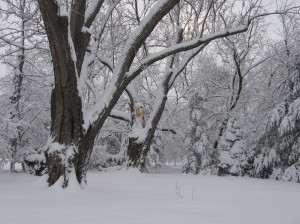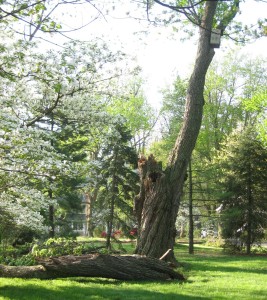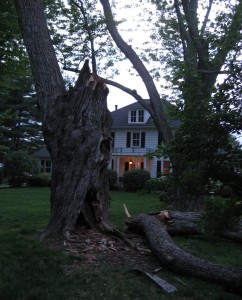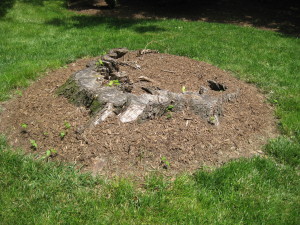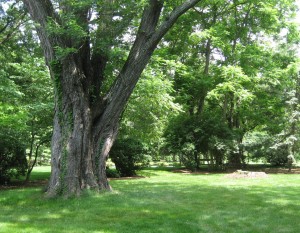They didn’t stay, much to our disappointment. My husband climbed a ladder to look into their former home, and saw that the shelf that had supported the nest had collapsed. He and D built an owl box together as a father-daughter project, in hopes that we could lure our feathered friends back again. In the photo immediately below, the box is visible in its first position on the tree. The owls evidently found it unsatisfactory. Maybe it wasn’t situated high enough, H thought. The following spring, he risked life and limb to attach the box much farther up in the tree, as shown in the second photo below. I remember my alarm when I returned from an errand one windy Saturday morning and saw him standing on a tall ladder by the tree, the owl box balanced precariously on one shoulder. Despite H’s grand gesture, the owls said No, thanks. They have not returned since, we are sad to say.
The immense old tree that sheltered our family of owls no longer stands. On a sunny Easter Sunday in 2011, we were eating dinner with my parents on the back porch when we heard a thunderous crash. We followed the sound to the front yard, where we discovered that half the tree had simply fallen to the ground. We knew it was nearing the end of its life span. Its hollowness was what had made it especially attractive to the owls. Still, it was painful to see so much of that massive tree splintered in pieces on the lawn.
On the tall remaining section, the never-used owl box was unscathed. Creaking sounds could be heard emanating from the tree. It couldn’t stand for long, and it was a danger, obviously. The next day, I watched with a heavy heart as the tree was slowly, painstakingly removed. It took a full crew and a huge bucket truck to reduce our dear big maple to a stump. The tree was ninety-one years old. Like the other five that once accompanied it, it had been planted in 1920, the year the house was built. I had recently spoken with one of the daughters whose parents had built the house. In her mid-nineties when we talked, she shared vivid memories of growing up in her family home. I told her how magnificent the maples were. She replied that she distinctly remembered the day she helped plant them, “from switches.”
Of the six original trees, only two remain. One day we will plant young trees in place of those we have lost. For now, though, the owls’ former home will be marked by a slowly deteriorating stump. Every tree company in northern Virginia, it seems, has stopped to give us a good price for stump grinding. We always say no. Unlike the owls, we find it hard to move on.
On the left, one of our two remaining silver maples. On the right, the stump of what will always be for us the owl tree.

